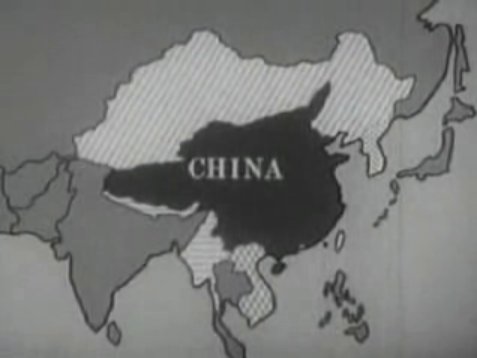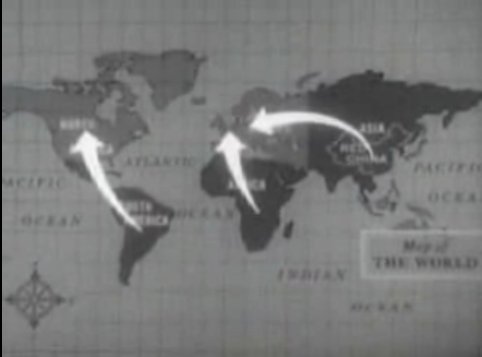Here’s a classic from the old days. Red Chinese Battle Plan was a full throated 1964 U.S. Navy propaganda film about China becoming global Communism’s “Second Rome” after Khrushchev said bad things about Uncle Joe and got sociable with the Americans. Its Chinese history seems a little strange:
This is in the beginning of the film, when the narrator tells us that “never had a major independent nation lost so much sovereignty, or suffered so much humiliation”. It doesn’t say exactly when, and the map doesn’t help. First we see Burma and what appears to be Nepal, Sikkim and Bhutan fall. As far as Wikipedia goes, Burma defeated 4 Qing invasions before falling to the British Raj, while the other three seem to have had their differences with Tibet, which would occasionally call on the Mongols or Qing to help. Even if there were tributes paid by these regions, they were most likely symbolic. It hardly seems fair to say they were Qing territory, and there doesn’t seem to be a particular timeframe for all of them going at once.
Then Xinjiang, Mongolia and Manchuria all seem to go at the same time. These regions were taken piece by piece by Russia, Japan and others, but not all of it (Xinjiang was a total basketcase) and not all at once. Then, weirdly, Korea falls after Manchuria, since the Sino-Japanese War was in 1895 and Russia invaded Outer Manchuria in 1900. The Nguyen regime in Vietnam defeated the Qing army invasion of Hanoi and then paid tribute to the Qing Emperor, but also set things up so officially “it was a child who dealt with Beijing”. Any comments untangling what all that implies are appreciated – Granite Studio? A little help? Sun Bin?
The most interesting bit, though, has to be Tibet staying on the team. Apparently in 1964 the U.S. Navy didn’t agree with the Dalai Lama that Tibet became de facto independent in 1911.
If you ignore the blatant rah-rah American freedom stuff in the movie, it does have periods of being reasonably informative. Then it talks about how Mao Zedong and Lin Biao (that didn’t work out) are going to conquer the world by invading the “rural countries” (Asia, Africa and Latin America) as stepping stones to the “city countries” (the U.S. and Europe):
Chinese communism never really pulled off stage one of this supposed “battle plan”. Chinese capitalism, on the other hand, appears to be making a go of it. Then again, as the Wall Street Journal points out, China’s investment in the U.S. dwarfs that in Latin America. I guess everybody wants to be in the cities these days.


Based on uncovered soviet dossiers I should say the plan was true. Mao Zedong even contributed more detail on it.
Very interesting, thanks for posting it. The film actually does a pretty good job of summing up Lin Biao’s pamphlet on communist strategy for world revolution — treating the “third world” as the countryside and the “first world” as urban areas. What was especially interesting about this idea of third world solidarity was the importance of self sufficiency: the idea that the third world could thrive without the know-how of the first world. China, of course, would be the leader in this grand coalition (which the film also points out).
It’s interesting too, if unsurprising, that the film presents the “free world” as homogeneous in its anti-communism, while many countries of the third world are presented as breaking away from Chinese influence. What is neglected in the film is the huge influence the Chinese example had on young leftists the US and Europe, which helped feed the protests of 1968. One need only watch, for example, Jean-Luc Godard’s “La Chinoise” (made in 1967) to see this influence at work in the 1960s.
Yeah, I was actually impressed with the start before we get into spit-take territory later on. That map of the Chinese empire at the start might give Chinese hypernationalists ideas, though.
@Vel: I’m not quite sure what your point is. I didn’t criticize the film for lacking timely information (I actually think it was surprisingly good at that given the circumstances), but instead questioned whether they got right the one part that they ought to have had adequate information on, i.e. historical data.
I focused on the presentation of history because that’s always been of interest on this blog, and because I wonder if they overstated the reach of Qing influence in order to strengthen their propaganda message. And especially because the Tibet thing is so oddly in sync with the Chinese argument, rather than their detractors.
I don’t even know where you get off calling Chinese an “indecipherable language”. For you, perhaps, but certainly not for countless other people, including 1960s Navy translators.
I am also of the view that, given the fact that it was done in 1960s in the West (without the informations that we enjoy today), the informations are surprising good, and ‘balanced’ when talking about Mao’s Long March and military theories (of course it tried to exaggerated Mao’s power and hence potential) in that it only twist and tipped when i needed to to make its case (of China threat). it was much better than the neocon approach IMO.
as the historical map piece, i suspect it took some work from the ROC materials, which by then tend to equate all tribute states as part of the manchu empire — for obvious reasons. i don’t have much to add in the geography, except that it seems to coincide with the ROC claim, eg, Tuva seems to be included.
http://en.wikipedia.org/wiki/Image:ROC_Administrative_and_Claims.png
regarding US position to Tibet in 1960s, i do not know but i would suggest some more research. i have the impression that the the stance became obvious only after 1980s, when Chiang has passed away. Before that, both DL and Chiang are US’s ally against Mao, and I would say Chiang got more attention and US didn’t really challenge the Tibet position to Chiang (ROC). so you are probably right that they didnt not really sided fully with DL back then.
this makes sense as DL is much less influential back then and he had to listen to whatever CIA said and to CIA Chiang weighed more than DL. but this are just my theories.
sorry for the typos/mistakes above 🙁
So, let’s put you in a library in 1964, and see if you can get accurate, unbiased, timely information about a country that is officially closed to the outside world, and who uses an indecipherable language.
Of all the things that a great rah-rah propaganda film could be blogged about, you spend the whole post criticizing its historical timeline? Seriously?